Caftans on the regiments: the multicolored rifle army of pre-Petrine Russia

Archers of the late XVI - early XVII centuries: 1 - archer of the Lithuanian prince Radziwill, 1564; 2 - Moscow archer of the late 3th century; XNUMX - a city Cossack of the early XNUMXth century. Rice. Angus McBride
"People walking", A.P. Chapygin
History uniforms. In general, a series of materials on the history of uniforms was published, and "requests from workers" immediately poured in - write, write ... "and when it will be ...", in a word, the fact that the topic will interest many, I was not mistaken. But among other wishes "out of time" one seemed worthy of attention. "Write about the archers", and - yes, indeed, about whom, about whom, and about them, the "hearts" should be written first of all. Because this "costume" army was among the first "uniform regiments" both in Russia itself and in Europe. Moreover, the rational nature of the rifle uniform is obvious. After all, both boots and an overcoat - all this came to us from there, from the era of archers!
Moreover, fortunately for the readers of VO, the “shooter theme” turned out to be not a passing one for me, but rather “long-playing”. It all started with the fact that in 1991 in the renewed Russia the first issue of the military history magazine "Zeikhhauz" was published, and it contained an article by Roberto Palacios-Fernandez "Moscow archers", for which he himself also drew excellent illustrations. Then I met him in absentia, and it turned out that he was a descendant of those Spaniards who ended up in the USSR in 1936-1939. At that time, I did not even dream of writing about something like that, only perhaps about tanks, which by that time had been engaged for 11 years, but then I thought that we also had archers in Penza, and why not write about them on the basis of documents, and use Roberto's drawings for ... redrawing. And with the appropriate changes Igor Zeynalov completed it, and this material went first to England in the magazine "Military Modeling", and then to the Netherlands in the magazine "La Figurin". It was told in these articles about the Penza fortress, and about its garrison, which consisted of archers, gunners, collars, foot and horse Cossacks and swan fishermen who caught swans at the royal table! While I was writing, I became interested in the archers and everything connected with them.
Well, then the British publishing house Osprey published my book about the army of pre-Petrine Russia, including about wooden fortresses, like my Penza, and about archers in colored caftans and coats of coats.
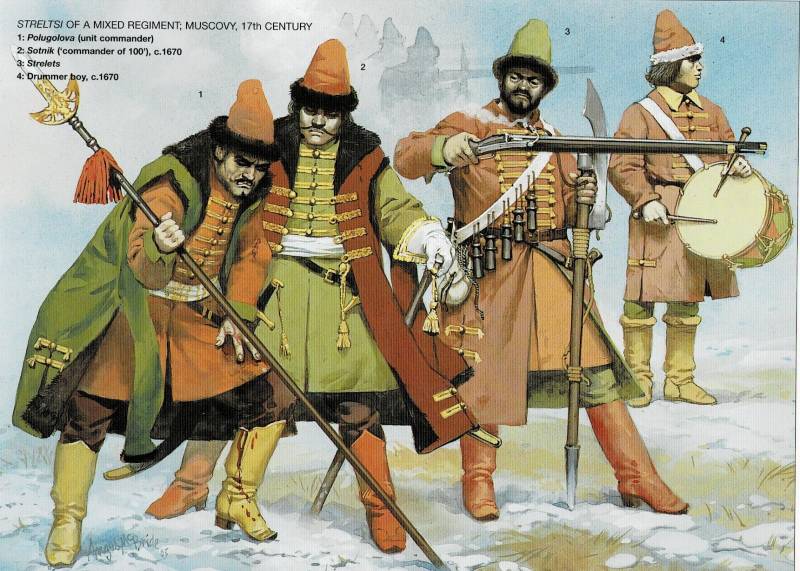
Riflemen of a mixed regiment aimed at suppressing Razin's uprising: 1 - half-head ("five hundred"); 2 - centurion approx. 1679; 3 - an ordinary archer; 4 - drummer boy. Rice. Angus McBride
Well, to begin the story about the rifleman uniform, of course, it should be noted that the history of the riflemen as a regular infantry of the Russian State began in 1550, when a detachment of 3000 men was formed from the then beepers. Under Ivan IV, there were already 7000 of them (2000 horsemen), and in 1584 - 20. At first, the "Streletskaya hut", later "Streletsky Prikaz" was in charge of their affairs.
The archers were from Moscow, who played the role of a kind of tsarist guard, and policemen, quartered in the cities.
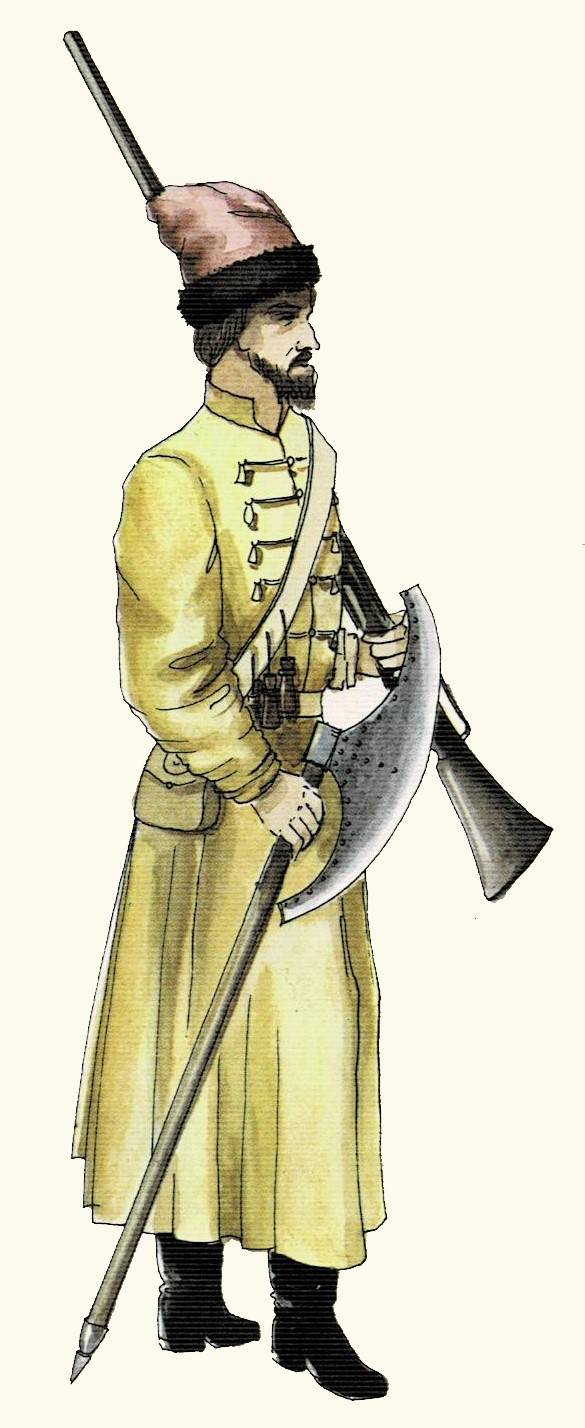
Russian Sagittarius 1675 - drawing from the book Foster G., Hoch P., Muller R. "Uniformen europaischer Armeen" VEB, Berlin, 1978. P. 67
The uniforms and weapons were common to all archers. All the archers, without exception (they had to be dressed!), Were dressed in a long-length "Russian cut" caftan, a sash with which the caftan was girded, a cap-cap and boots. That, in fact, is all we know about them. Initially, the color of the caftans could be very different. So, the Englishman D. Horsey wrote about the archers of Ivan the Terrible that they “very neatly dressed in velvet, multi-colored silk and stamed clothes". And he added: “... a thousand archers in red, yellow and blue robes, with shiny weapons and squeaks are placed in the ranks by their superiors».
Another Englishman J. Fletcher in 1588 described them as follows:
Many other foreigners who visited Russia also wrote about the archers. So, one of them described the archers of the middle of the XNUMXth century as follows:
That is, some part of the archers had caftans green, but also scarlet - these are also found in the descriptions of foreigners.
Then the Swede Erik Palmqvist in 1674 wrote his "Illustrated Book of Russia", which contained 53 drawings of various formats, and among the drawings of his book there are images of archers (p. 247), and on p. 254 there was even an image of a Russian archery berdysh with holes along the butt! Actually, any artist could then simply take and redraw these images. Moreover, there were four figures: regimental officers and an ordinary rifleman in full armor.
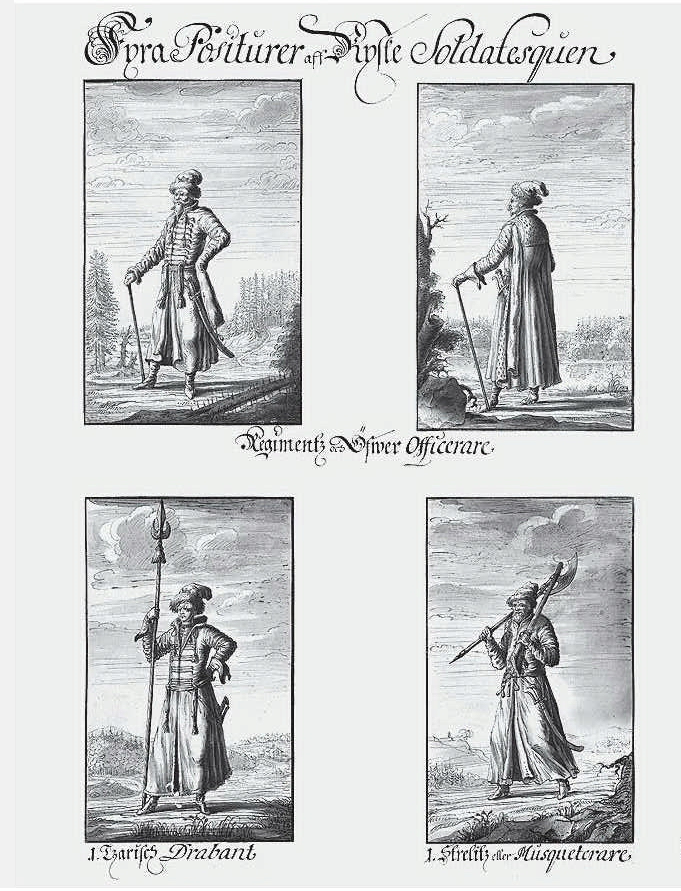
The commanding people of the rifle regiment and the private rifleman. E. Palmkvist "Illustrated book about Russia", 1674. Facsimile edition. Boris N. Presidential Library Yeltsin, Moscow
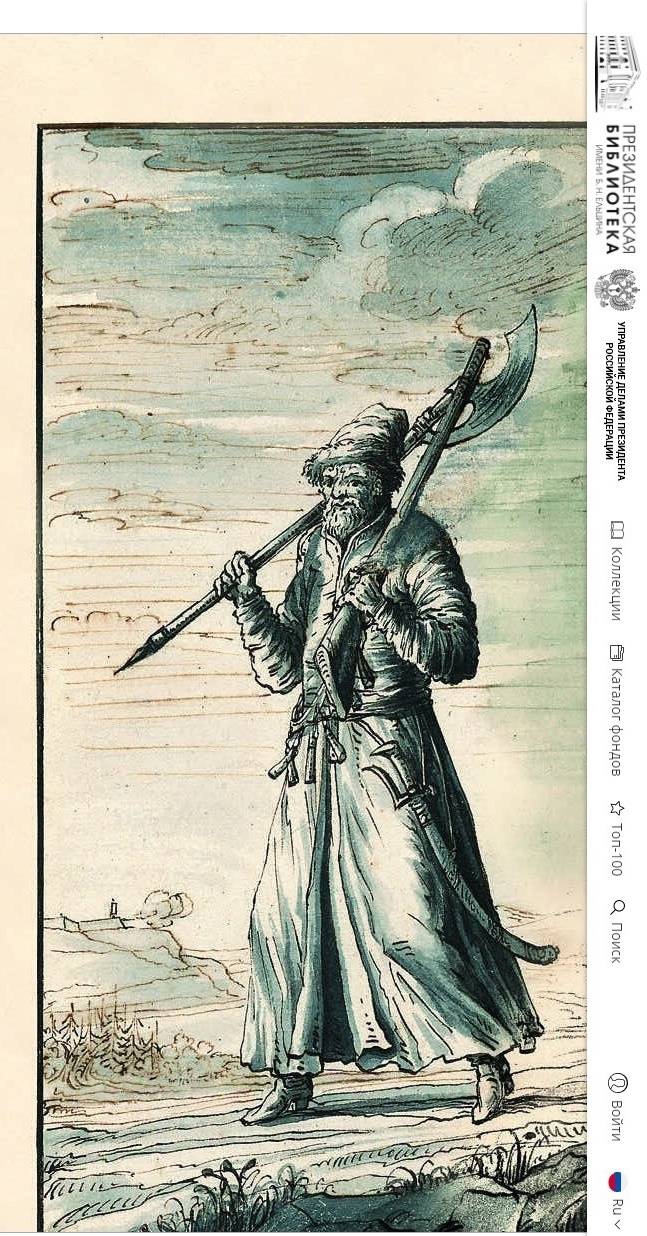
The same illustration showing a close-up of the archer
Palmkvist also writes that there were 14 rifle regiments in Moscow, named after their commanders, giving their numbers and the full range of colors of their uniforms. That is, thanks to this book, we have a source of exceptional value on the uniforms of our rifle regiments.
The regiments were commanded by "shooters' heads" (tysyatsky), half-heads (five hundred), centurion officers and sergeants (pentecostals and foremen). Boyars and princes were often their heads. The rest of the children of the boyars and nobles became the sergeants from the archers themselves. On March 25, 1680, the archers were ordered to “command against a foreign rank", That is, the commanding ranks to be"from heads to stewards and colonels, from half heads to semi-colonels, from centurions to captains". The Sagittarians didn't like it, but they had to do it. Peter I completely abolished all Moscow archers in 1711, but city archers existed in cities until 1716.
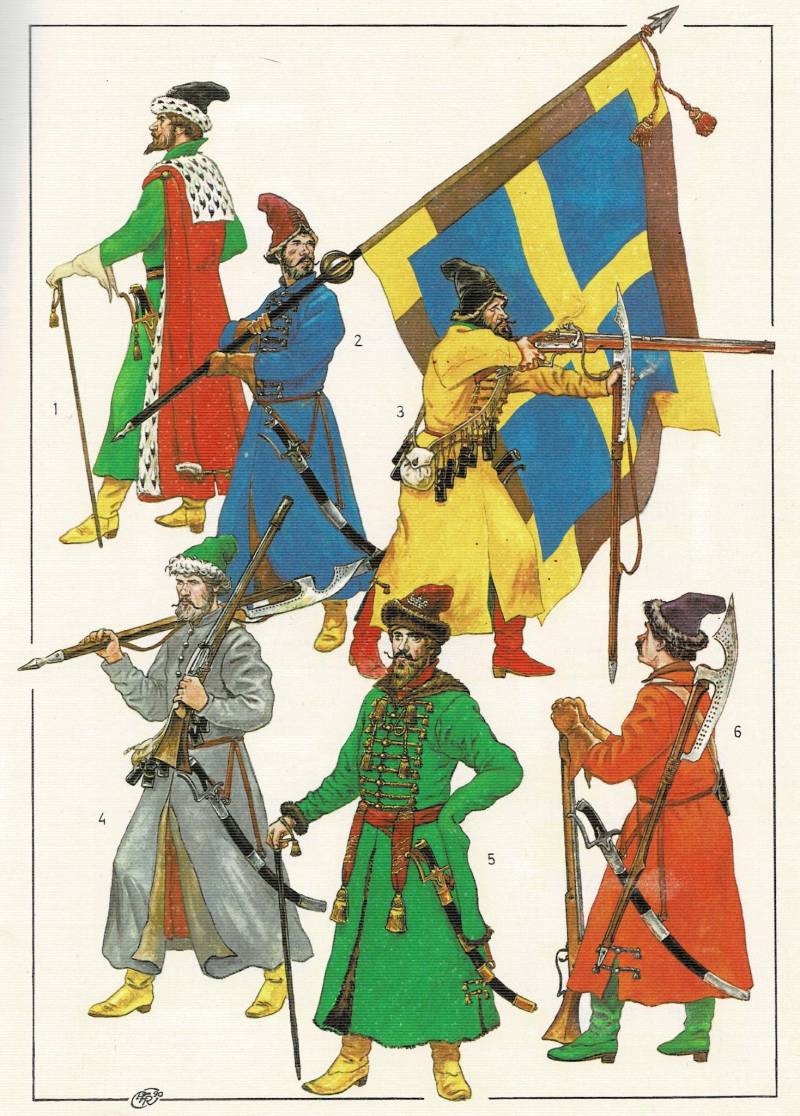
Streltsy of the "colored" Moscow regiments of 1672 (based on the book by E. Palmkvist): 1 - shooter head E.P. Lutokhin; 2 - a standard-bearer with a hundredth banner; 3 - archer of the 3rd regiment; 4 - a shooter of the 13th regiment in a marching uniform - a homespun caftan; 5 - five hundred (or "five hundred") of the 3rd regiment; 6 - archer of the 8th regiment
Now let's look at one more illustration by R. Pallacios-Fernandez, again based on the book by E. Palmqvist. True, it was impossible to determine the colors of the ports (trousers), the lower caftan and the sash from his (Palmqvist's) drawings, therefore, as you can see, they are not shown here. Perhaps, the original colors of the caftans were conveyed not quite accurately when printing, and the colors of that time from natural dyes, it was hardly possible to reproduce accurately. Nevertheless, let's see ...
Moscow regiments and centesimal banners from the Strelets' orders of 1674 (according to E. Palmqvist):
The 1st stirrup regiment of Yegor Petrovich Lutokhin had the largest number - 1500 people. A red caftan with a yellow lining, boots of a yellow farm (constantly mentioned in the novel "People Walking" by Chapygin), a hat with a fur band, for ordinary archers with sheepskin fur, and for bosses with sable.
2nd - regiment of Ivan Fedorovich Poltev - 1000 people. At Chapygin they are constantly called white caftans, that is, they wore caftans made of white cloth. But in the above illustration, their color is different, rather blue.
3rd - regiment of Vasily Borisovich Bukhvostov - 1000 people. Green caftans and, again, yellow boots. Apparently, the material from which they were sewn was then very common. The 14th regiment was dressed in the same way - Afanasy Ivanovich Levshin, numbering 1000 people, but they differed in the lining of the caftans.
4th - regiment of Fyodor Ivanovich Golovlinsky - 800 people. The color of the caftans is crimson, just like in the regiment of the 11th Davyd Grigorievich Vorontsov, numbering 600 people.
5th - regiment of Fyodor Vasilyevich Aleksandrov, numbered 800 people, dressed in "meat-colored" caftans.
6th - regiment of Nikifor Ivanovich Kolobov, consisting of 900 people. Yellow caftans, green hats and ... red, for distinction, boots.
7th - regiment of Stefan Fedorovich Yanov - 1000 people. Apparently dressed in blue caftans.
8th - regiment of Timofey Fedorovich Poltev - 800 people. Just like the 10th - Fyodor Abramovich Lopukhin (1000 people), he wore orange caftans (in R.P-F's illustration they look like orange, but rather it was still red) cloth and, again, green leather (or suede) boots.
9th - regiment of Peter Abramovich Lopukhin - 1200 people. He was dressed in dark blue caftans (purple in the illustration) with orange or red lining and complete with yellow boots. A similar color was for the riflemen of the 12th regiment - Ivan Ivanovich Naramansky, 600 people. But only the lining was of a different color.
Finally, Lagovskin's 13th regiment (600 men) had the same caftans as in the 9th and 12th regiments, but differed in green cloth caps and lining.
It is difficult to determine the colors of the lapel tabs; moreover, they simply were not on the field caftans. Only buttons. But it is known that on campaigns the archers very often wore white, gray and black coats of coats, and the treasury released bad cloth on the hats, that is, it quickly faded. Also, there were no colored "uniforms" of city archers. All of them sported in sermyaga caftans.
As for weapons, the archers were armed with a match musket and a reed - a moon-shaped ax with a long shaft that could be worn on a belt behind the back. It was used as a support for a musket, and as a weapon of the security service in cities. The holes on the butt served for the rings with which the sentinel archers thundered at night, bypassing the city with a patrol and frightening the "dashing people" at the same time, and letting the lattice guards (street guards who locked each street on the "lattice") know that they had to go out and ... open pass them. In general, as you can see, wandering around the streets of old Russian cities at night was not at all easy, as they say - neither walk nor drive!
All archers wore sabers. In the XNUMXth century, the Polish model. The people in command were recognized by the protazans.
The only protective armor of the archers could be an "iron hat" worn on a cloth hat that served as a comforter. But, apparently, it cannot be said that the archers abused wearing it!
There were three types of banners: regimental (richly embroidered, rarely put into service), centennial (company), often sewn from the fabric of regimental uniforms and usually with a colored cross, and small "fifty" or fraternal banners - in fact, small flags.
It is interesting that cloth for caftans was released to Moscow archers annually, according to a report in 1660, but to the policemen - once every three or four years. The edibles were also centrally dispensed: for the archer, a half-carcass of mutton every week, and for the ten's manager - a carcass, and for the archer three, and for the ten's manager five loaves of bread per week "on the shovel of the planted". Well, those who are higher - were given accordingly. How much was plundered in this case ... no one knows!
It is interesting that, despite the decree of Tsar Alexei Mikhailovich, it is common to wear beards and mustaches without trimming, the archers, as they wanted, cut their hair, mostly in a circle, and many even shaved.
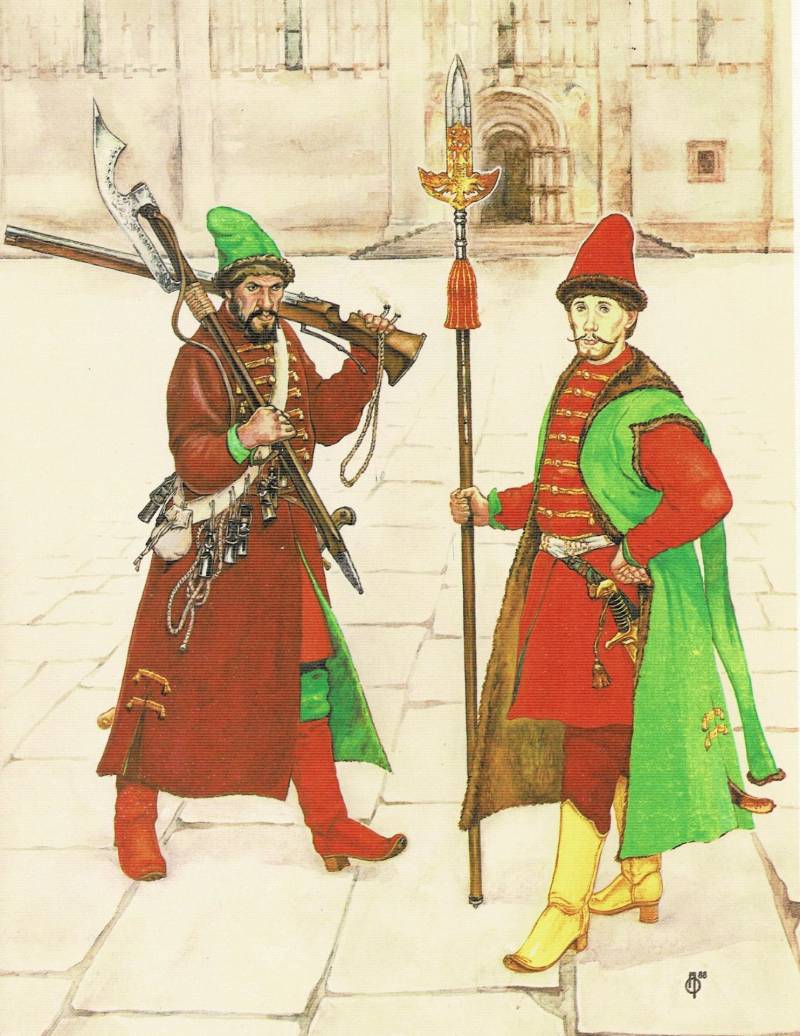
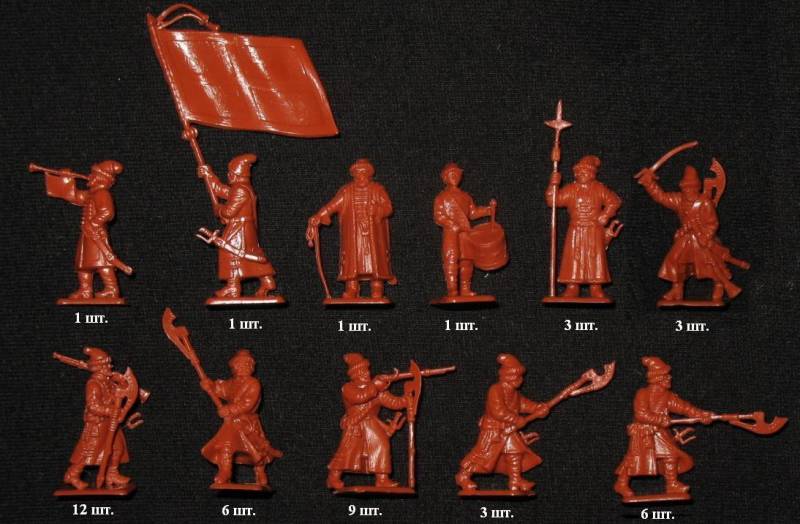
Information